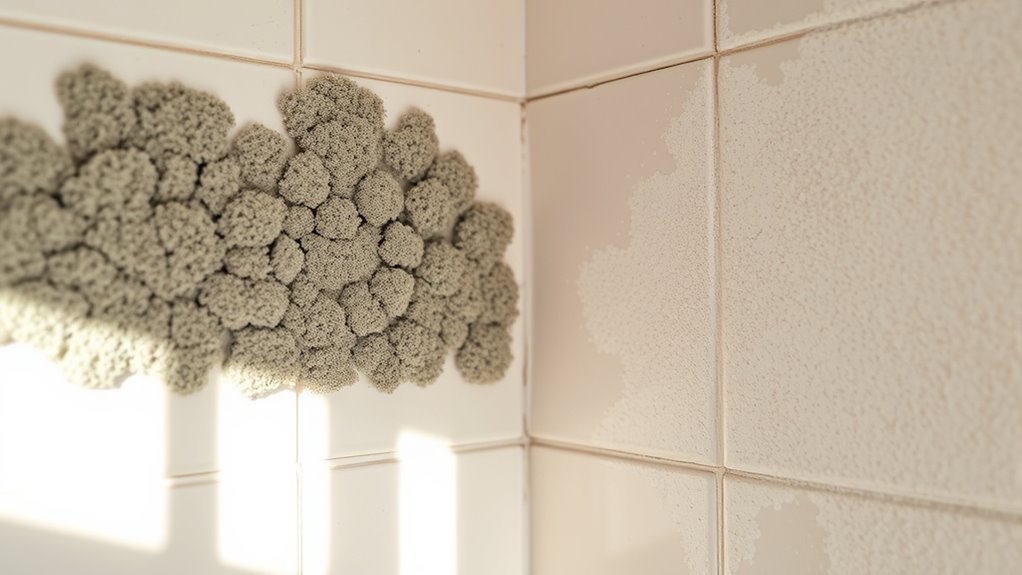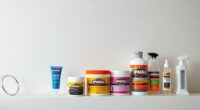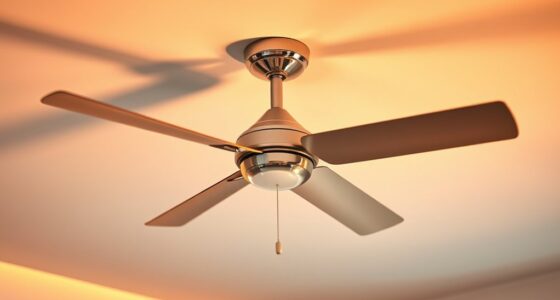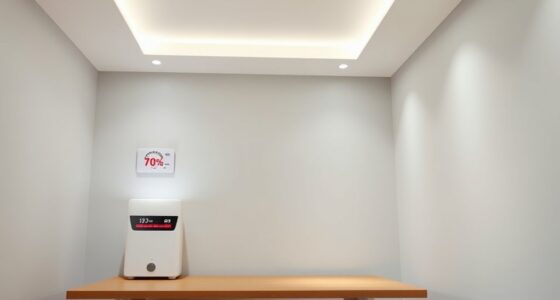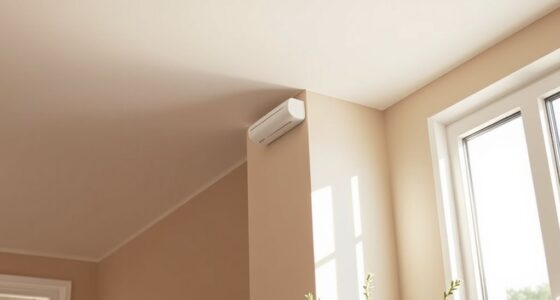To spot the difference, check the appearance: mold is fuzzy, in darker colors like green or black, and often grows in hidden spots, while mildew looks flat, powdery, and is usually white or gray. Both thrive in moist areas, but mold poses greater health risks. Acting quickly with proper cleaning and moisture control can stop their spread. Keep going—understanding these differences helps you treat mold and mildew fast and keep your home safe.
Key Takeaways
- Mold appears fuzzy or slimy, often in hidden areas, while mildew is flat, powdery, and usually visible on surfaces.
- Mold is typically green, black, or gray, whereas mildew is commonly white or gray.
- Mold poses higher health risks, releasing spores that can trigger allergies and respiratory issues.
- Mildew is easier to clean with vinegar or baking soda, while mold may require professional removal.
- Control moisture and ensure proper ventilation to prevent both mold and mildew growth.
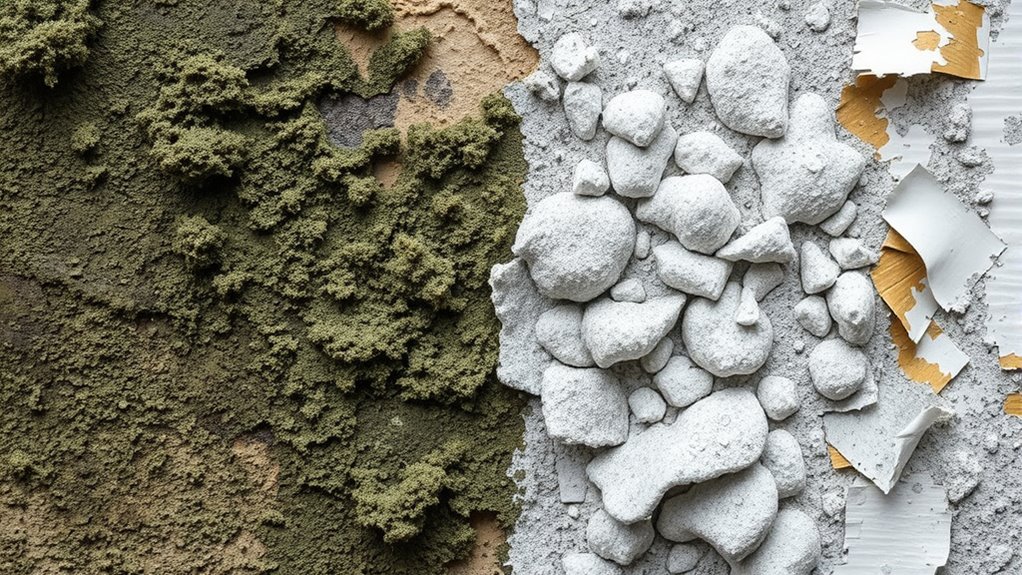
Have you ever wondered what distinguishes mold from mildew? While they’re both types of fungi that thrive in damp environments, understanding their differences can help you take quick action to improve indoor air quality and prevent health issues. Mold tends to grow in hidden, less visible areas and often appears fuzzy or slimy in shades of green, black, or gray. Mildew, on the other hand, usually shows up as a flat, powdery, or fluffy surface, often in white or gray, and tends to grow on surfaces like bathroom tiles, window sills, or fabric.
Knowing these differences matters because mold generally poses a greater health risk. It releases spores into the air that can trigger allergies, asthma, or respiratory problems, especially if you’re exposed over time. Mildew’s spores are less invasive but can still cause irritation and contribute to poor indoor air quality if left unchecked. To keep your home safe and healthy, it’s vital to address both types promptly through effective cleaning methods. Regular cleaning with antifungal solutions, such as diluted bleach or commercial mold removers, can eradicate surface growth. For mold in hidden areas, like behind drywall or under carpets, you might need professional remediation to make certain it’s completely removed and doesn’t return.
Mold poses greater health risks and requires prompt, often professional, removal to prevent allergies and respiratory issues.
Improving indoor air quality is an essential part of controlling mold and mildew. Ventilation helps reduce moisture buildup, making your home less inviting for fungi to thrive. Using exhaust fans in bathrooms and kitchens, fixing leaks promptly, and maintaining dehumidifiers at ideal levels all contribute to a drier environment. When cleaning, it’s important to wear protective gear like gloves and masks to avoid inhaling spores. After treatment, make sure surfaces are thoroughly dried because moisture encourages regrowth. In some cases, replacing contaminated materials, like drywall or carpeting, might be necessary to fully eliminate the problem. Additionally, understanding headphone compatibility and correct pairing methods can help you enjoy your audio experience without interruptions, especially when using wireless or Bluetooth options.
Understanding the difference between mold and mildew also guides your cleaning methods. Mildew is easier to clean and less invasive, so regular scrubbing with a mixture of water and vinegar or baking soda can often do the trick. Mold, especially if it’s extensive or persistent, demands more aggressive treatment and possibly professional intervention. Keeping up with routine cleaning and moisture control not only preserves your home’s appearance but also safeguards your indoor air quality. Acting fast when you spot signs of either fungi prevents health risks and avoids costly repairs later. By staying vigilant and knowing how to identify and treat mold and mildew, you can maintain a healthier, safer living environment.
Frequently Asked Questions
Can Mold and Mildew Cause Health Problems?
Yes, mold and mildew can cause health problems. When you breathe in indoor air contaminated with toxic spores, you might experience allergies, asthma, or respiratory issues. Mold releases airborne toxins that can irritate your eyes, skin, and lungs, especially if you have allergies or a weakened immune system. It’s important to identify and treat these issues quickly to protect your health and improve indoor air quality.
Are There DIY Methods to Remove Mold and Mildew?
Yes, you can try DIY cleaning with natural remedies to remove mold and mildew. Use a mixture of white vinegar and water or baking soda paste to scrub affected areas. For light infestations, these methods often work well. Make sure to wear gloves and guarantee proper ventilation. Regular cleaning with natural remedies not only helps remove mold and mildew but also reduces chemical exposure, keeping your space healthier.
How Long Does It Take to Eliminate Mold or Mildew?
You watch as the dark patches linger, and wonder how long it takes to eradicate mold or mildew. Typically, the growth duration influences the removal timeline—small spots might clear in a few days with DIY methods, but extensive infestations could take a week or more. Patience is key; thorough cleaning and proper drying ensure effective removal, preventing future growth and safeguarding your space.
Are Certain Materials More Prone to Mold or Mildew Growth?
Certain materials are more prone to mold or mildew growth due to their surface porosity and material susceptibility. Porous surfaces like drywall, fabric, and wood trap moisture, making them ideal environments for mold and mildew. Non-porous materials like glass or tile resist growth but can still harbor spores if moisture persists. To prevent issues, keep surfaces dry and consider using mold-resistant paints or treatments on susceptible materials.
When Should I Call a Professional for Mold or Mildew?
You should call a professional when mold or mildew stubbornly persists despite your efforts, when it covers large areas, or if you notice health symptoms like allergies or respiratory issues. Use inspection tips, such as checking hidden spots and hidden moisture sources, to identify the problem early. Prevention strategies, including controlling humidity and fixing leaks, help stop growth. Reach out to experts for thorough cleaning, testing, and lasting solutions.
Conclusion
Now that you know the key differences between mold and mildew, you’re better equipped to spot them early and take action. Remember, quick treatment can prevent health issues and property damage. So, next time you see those fuzzy spots or dark patches, will you ignore them or tackle the problem head-on? Taking swift steps keeps your home safe, healthy, and mold-free. Don’t wait until it’s too late—your space deserves your prompt attention!
